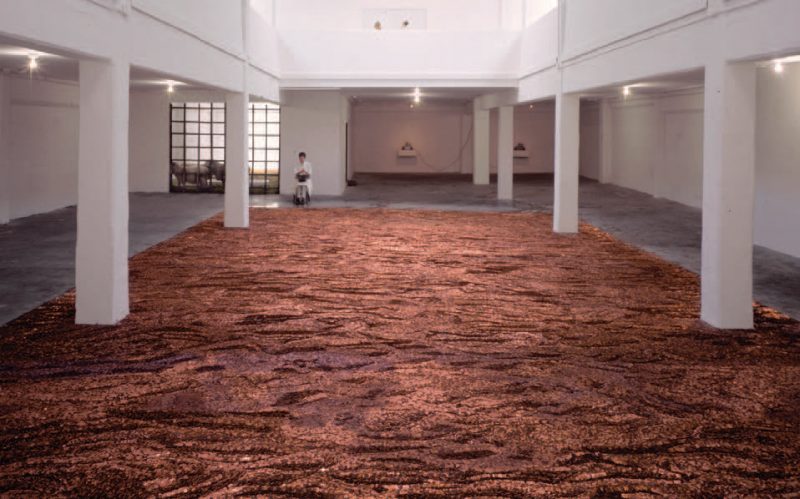Installation artists must be engineers, carpenters, salesmen, and actors, all at once. Space and labor are the only requirements all installations demand. As such, budgets vary mightily. Installation budgets may be complex, detailed grant proposals, or, like some of the accounting records from the project described below, handwritten tallies on a four-by-six-inch yellow notepad.
Ann Hamilton created this project, called privations and excesses, to transform an indoor space in San Francisco. Her installation, which included a wave-like sculpture made of pennies, was funded through an artist-in-residence program called the Capp Street Project. Hamilton received three months in which to build, display, and remove her work. She also recieved $8,000 and a living stipend, making this a less expensive installation.
The figures listed below are 1989 dollars. The 1989 dollar is worth roughly $1.71 today. Observant readers may note that Hamilton spent more than her $8,000 allotment; this is because she transformed most of her grant into more than half a million pennies. She effectively spent the pennies twice: once as building materials and once as currency. The leftover pennies, constituting several thousand dollars, were donated to charity.
This is an installment of Creative Accounting, an ongoing series that explains where the money goes for projects in the creative industries. Future issues will cover television, fine art, theater, and music. Eventually the series will be collected into a single, indispensable volume, published by Believer Books.
—Christopher Benz


PRODUCTION $9,837.97
CONSTRUCTION $7,080.56
Labor $0
Installations are often far too large for one person to build single-handedly. Hamilton persuaded volunteers to donate time or materials to the installation. At least two college art classes helped, and other volunteers worked long nights or shared their expertise.
Food $100
Volunteer morale is cheaply bought.
Hardware $6.49
Tools $0
Hamilton brought her tools from home.
Physical Materials $6,974.07
Copper Pennies (650,000) $6,500
Volunteers sculpted the pennies into shapes in a 32 x 47-foot carpet along the floor. Their acquisition from the bank required persistent negotiation. Brinks security delivered them in two trips of an armored car.
Honey (10 gallons) $235
Hamilton laid the pennies into a skin of honey that leached out at the edges.
Wire Mesh $13.74
Sheets $8.00
Wall-mounted, electric mortar and pestle $212.33
As a state employee, Hamilton was able to buy industrial items from the California State Surplus lot at a discount.
Motor $125.83
Bearings/gatebelts $12.57
Repairs 3.93
...
You have reached your article limit
Sign up for a digital subscription and continue reading all new issues, plus our entire archives, for just $1.50/month.
Already a subscriber? Sign in




